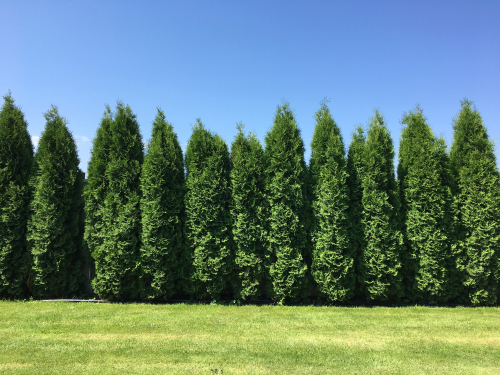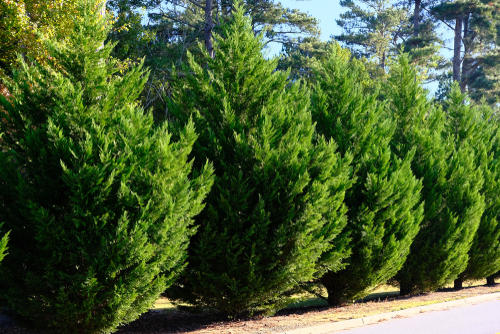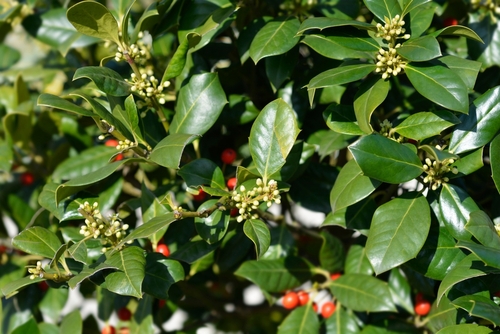In landscape design, privacy trees create an excellent natural buffer and deliver an opportunity to create a more serene outdoor area. Pools and outdoor patios often call for the need for additional separation from neighbors or frequently traveled roads. If your property is located in an older neighborhood, you are most likely surrounded by well-established trees or shrubs that have been planted decades ago. The real challenge comes when moving into new areas where landscapes have not yet been established, and privacy is a real concern. Working with a landscape professional is usually the best option, especially in the planning phase, as natural screen benefits are not limited to privacy. They can also provide noise reduction and energy efficiency, often delivering shade for your entire property.
Evergreen vs. Deciduous Trees
Evergreens keep their foliage year-round, and when planted close can provide complete privacy. Often considered a living hedge, they are a fantastic option and much lower in maintenance than a traditional fence.
Deciduous Trees are a great privacy option with dense foliage in the summer months. They lose leaves for part of the year, typically during the colder months or dry season. They are better suited for yards where privacy needs might be seasonal, and the primary goal is to create shade during the warmer months.
Popular Species of Privacy Trees well-suited for the Central North Carolina climate
The Triangle region of North Carolina features mild winters, well-draining soils, and stays hot and humid most of the summer. Look for the best privacy tree recommendation based on soil quality in your area, space, and sun exposure. The following five species of privacy trees tend to perform well in our region.

Thuja Green Giant
Starting with the most popular option, the Thuja, often known as an Arborvitae, is a large, woody, needled evergreen tree in the cypress family. It is a hardy, disease and drought-resistant tree that tolerates most soils. It requires no maintenance to keep its shape and retains its deep green color year-round. Green Giants are very fast-growing, averaging 3 to 5 feet of growth each year.
- Mature height 40-60 feet tall and 12-18 feet wide
- 40-60 year lifespan
- Hardy and low maintenance

Leyland Cypress
This very fast-growing evergreen can reach a maximum height of around 60 to 70 feet at full maturity. Thriving in full sun, it can be prone to disease, especially in areas of high humidity. It is characterized by dark green twig-like branches that are lightly aromatic and soft to the touch. With a growth rate of 3-5 feet each year, Leyland Cypress has become one of the most attractive screening trees in the North Carolina region.
- High tolerance for poor soil, drought, and air pollution
- Mature height 60-70 feet tall and 12-18 feet wide
Annual growth rate: 3-5 feet

The Nellie R. Stevens Holly
This shrub is one of the best choices for creating a uniform hedge that will not turn brown in heat or drought. It can be easily pruned to a desired shape, and it features dark green, waxy, and shiny leaves and bright red berries in winter. One of the main advantages of Holly shrubs is their deer-resistance and drought tolerance. The red berries will attract birds and small mammals, offering a great source of food in the winter months.
- Maximum height of approximately 15 to 25 feet at full maturity
- Annual growth rate: 3 feet

Flowering Dogwood
A deciduous tree option reaching a maximum height of only 12-15 feet. The dogwood flower is the state flower of North Carolina, attracting bees and butterflies in the summer and birds and other wildlife from fall through winter. In the piedmont area, it is best to plant it in partial shade, in a well-drained soli rich in organic matter. It’s biggest threat is being prone to fungi and wood boring insects.
- Maximum height of 12-15 feet
- Requires well-drained soil

White Oak
The most sought-after hardwood in eastern and central parts of the country, white oak is not a white-bark tree, and its name actually comes from the shade of the wood after the harvest. Reaching a massive canopy, this tree will require more room to plant and provide outstanding shade. The fall color is often reddish-brown to reddish-purple, making it an attractive addition to any backyard. White Oak thrives in rich, moist, well-drained acidic soil and full to partial sun.
- 80 feet tall by 100 feet wide at maturity
- Hardie tree
- Acorns take a single season to develop
How Much Do Privacy Trees Cost?
If you have ever visited a nursery, you know that plants and trees come in many varieties and price points, which widely depend on the type and size of the plant. If you have budget constraints, it might be best to opt for a faster-growing tree or a shrub that can create a full privacy screen in just a few short years.
Our Landscape Design Team
We strive to deliver the best overall landscape design for our clients that not only serves the purpose today but one that will mature gracefully, bringing even more privacy to the property. Speak with our landscape designer to see what privacy tree option might be best for you.